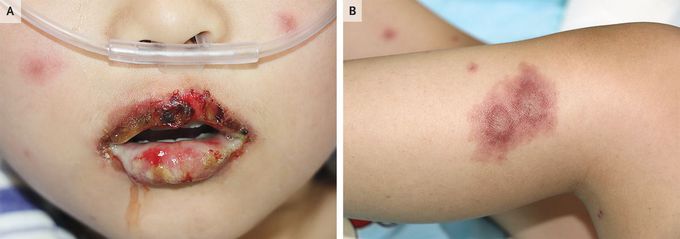


Mycoplasma-Induced Rash and Mucositis
An 8-year-old girl was brought to the dermatology clinic with a 3-day history of painful lip crusting, oral ulcers, rash, and genital pain. Ten days before presentation, a fever and cough had developed. She had no history of medication use. Physical examination was notable for conjunctivitis in both eyes and ulcers in the oropharynx. There were scattered vesicular lesions across her face, and her swollen, bleeding, exudative lips made it difficult for her to open her mouth (Panel A). Targetoid lesions with vesicles were scattered across her arms and legs (Panel B, left leg), and multiple small ulcers were found in the vulvar and perianal regions. Rales were present in both lung bases. Imaging of the chest showed infiltrates in both lungs. A serum IgM antibody test and a sputum polymerase-chain-reaction test were positive for Mycoplasma pneumoniae. A diagnosis of mycoplasma-induced rash and mucositis was made. Although this postinfection mucocutaneous syndrome may manifest in a way similar to the Stevens–Johnson syndrome, the prognosis is more favorable. Supportive care was administered, and treatment with doxycycline was given for the pneumonia. Two weeks after presentation, the mucocutaneous lesions had abated, and the pneumonia symptoms resolved soon after.

